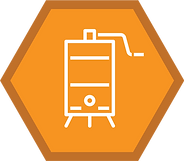
Winter Beehive Wrap Special
Starting October 15
-
Frame by frame beehive inspection
-
Pollen patty and candy board or fondant patty application
-
Oxalic mite treatment
-
Set up beehive boxes for winter (location, angle and ventilation)
-
Clean and inspect bottom board
-
Installation of insulated roof with winter wrap
Provide emergency Feeding if Hive is light


Spring Time Backyard Beehive Management
During Spring time you should really be visiting your hives once a week to ensure the queen and brood is healthy and manage any swarm urges. Honeybees are very busy this time of year a lot can happen in just one week.
Preparation:
-
Unwrap the winter wrap
-
Clean and assess the health of the beehive and queen
-
New beehive installation(s) and set up
-
Mite treatment and pest management
-
Swarm control
-
Splitting beehives and adding honey supers
-
Removing honey supers

Summer and Fall Time Backyard Beehive Management
During summer the bees are still very busy and their main beehive box(s) should be full of honey and pollen. Nectar and pollen sources become less available and by mid to late August – winter preparation has already started. A beehive check should be done at least every two weeks.
Preparation:
-
Remove honey supers
-
Check for the queen and brood
-
Mite checks and treatment
-
Sugar supplement feeding and medication (we use essential oils)
-
Ensure honey and pollen frames are full for winter

Winter Time Backyard Beehive Management
Although your bees are all wrapped up it is still important to ensure visual inspections and clean up around the front of the beehive. Sometimes dead bees can clog the entrance. Ventilation is key as trapped moisture in the hive can kill the bees. It is also recommended not to go into your beehive when it is really cold outside. Opening the hive will disrupt how the bees regulate their heat and too much interference can kill them. Preparation is key to the health and survival of your honeybees over winter. We recommend one visual inspection each month or after heavy rains. cold snaps, or snow.
Preparation:
-
Ensure the bees have lots of pollen and honey for winter
-
Provide supplemental / medication treatment feeding
-
Do a mite check and treatment
-
Visual inspections
-
Clean and prepare equipment for spring.
-
Read a bee book
























